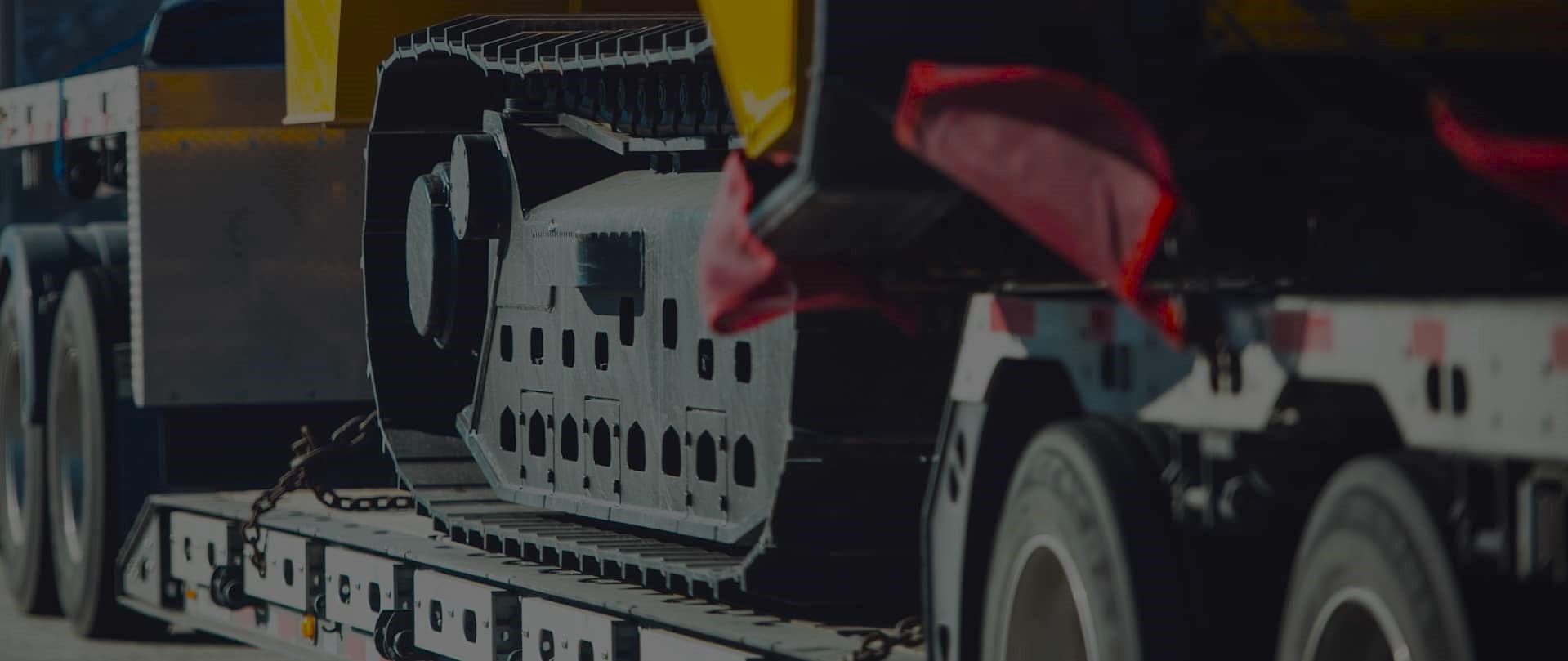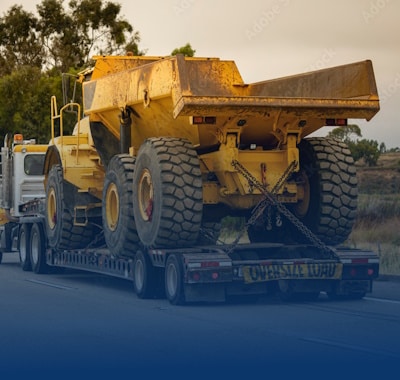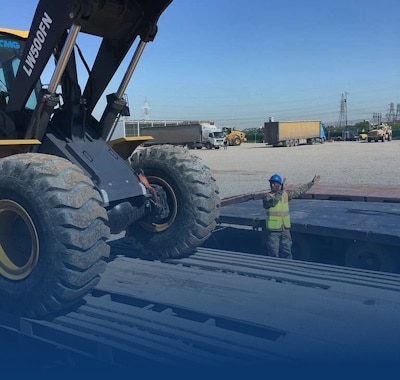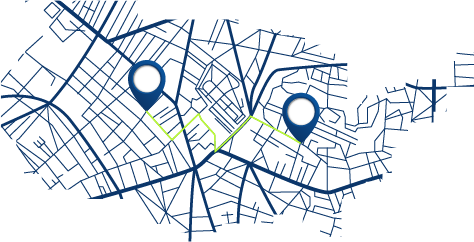Oversize Load Permits: Essentials for Moving Big Machinery
Freedom Heavy Haul can offer expedited Pickup and Delivery for any size shipment anywhere in the USA. Contact us today for No Hassle, No Pressure Pricing.
Moving heavy equipment across American roads demands careful planning. Specialized transportation of industrial assets like bulldozers and cranes requires strict legal compliance. Proper permits are not optional; they are mandatory for safety and legality.
We understand the complex requirements involved in moving a heavy load. Failure to secure the correct authorization can lead to severe consequences. These include costly fines, major project delays, and even equipment impoundment.
Our expertise lies in navigating this intricate permitting landscape. We help clients move their valuable equipment safely and efficiently. This guide covers the entire process, from legal frameworks to route planning and insurance.
Understanding these rules protects public safety and prevents road damage. It also manages traffic disruptions and documents responsibility for each move. This article serves as your comprehensive resource for informed decision-making regarding oversized loads.
We are committed to ensuring your transportation projects proceed smoothly. Proper planning for your load and securing the necessary permits is the foundation of a successful move. Let us equip you with the knowledge needed for your next project.
Understanding Oversize Load Permits and Their Importance
The movement of equipment beyond standard road parameters demands specific governmental approval. We define a permit load as any shipment exceeding established size or weight restrictions. These over-dimensional assets cannot travel legally without special authorization.
Jurisdictional rules vary significantly across different governing bodies. Federal, state, and local agencies each set their own specific requirements. Understanding these variations is crucial for compliant transportation.
Key Terms and Definitions
Several important classifications determine the type of authorization needed. Over-dimensional refers to assets exceeding standard size limits. Overweight indicates gross vehicle weight surpassing legal thresholds.
Non-divisible loads cannot be separated without compromising their function. Superloads represent the most extreme category of oversized shipments. Each classification carries distinct regulatory requirements and approval processes.
Standard legal dimensions typically include specific measurements. Common thresholds are 8’6″ width, 13’6″ height, and 53′ length. Weight restrictions often cap at 80,000 pounds for standard vehicles.
Benefits of Proper Permitting
Proper authorization serves multiple critical functions for safe transportation. It ensures public safety by managing potential road hazards. This process also prevents damage to infrastructure like bridges and roads.
Effective permit management controls traffic flow during specialized moves. It establishes clear accountability for all parties involved. Comprehensive documentation protects your business from legal complications.
Beyond compliance, proper authorization offers significant operational advantages. It enables optimized routing and potential cost savings. This approach provides peace of mind throughout the entire transportation journey.
Legal Framework and Regulatory Compliance for Heavy Equipment Transport
Jurisdictional authority over road use for specialized shipments is divided among various government entities. There is no single, universal solution for authorization. Understanding this layered system is the first step toward full compliance.
We guide clients through this intricate web of regulations. The correct type of authorization depends entirely on which entity owns the roads your equipment will travel.
Federal vs State Regulations
Federal regulations primarily influence interstate commerce and national highway standards. However, most permitting power rests with individual states. This creates a complex patchwork of rules.
Each state sets its own unique requirements. These include specific size and weight limits, application processes, and escort vehicle rules. Approval timelines and fees also vary significantly.
Local Permit Requirements
Beyond state-level permits, local authorizations are often critical. County or city permits govern travel on municipal streets and county-owned roads. These are essential for the first and last miles of a journey.
Multi-state transportation of heavy loads requires separate approvals from every jurisdiction crossed. This multiplies the planning complexity. What is legal in one state may need special permission in another.
We emphasize the importance of understanding these jurisdictional differences. Staying current with changing regulations across multiple areas is challenging. This is where our expertise provides a distinct advantage for your project’s success.
A Step-by-Step Look at How Oversize Load Permits Work for Large Machinery
Securing proper authorization for transporting industrial assets follows a structured sequence of essential actions. We guide clients through this systematic process to ensure efficient movement of valuable equipment. Each step builds upon the previous one for successful outcomes.
Detailed Steps in the Permit Process
The first critical step involves documenting exact specifications. This includes gross weight, per-axle measurements, and precise dimensions. Origin and destination details complete this foundational phase.
Route analysis comes next in the sequence. We examine bridge capacities, road widths, and overhead clearances along every mile. Some substantial loads require professional engineering surveys.
Application submission represents the third step in this process. Required documentation includes vehicle registration, insurance verification, and driver credentials. This phase typically occurs through online portals or specialized services.
The final phase involves review and approval by transportation authorities. Officials assess route safety and may require adjustments. They then issue operational guidelines and specific restrictions.
Understanding this comprehensive process helps plan realistic timeframes and budgets. Accuracy at each step prevents costly delays. Proper planning ensures smooth transportation of industrial assets across multiple jurisdictions.
Planning Your Route: Costs, Restrictions, and Optimal Paths
Strategic route planning forms the foundation of successful heavy equipment transportation. We emphasize this critical phase must occur before any permit applications begin. The chosen path directly impacts authorization requirements, project costs, and overall feasibility.
Assessing Your Freight’s Route
Effective planning examines multiple factors along potential routes. We evaluate bridge weight capacities, overhead clearances, and road width restrictions. Seasonal construction zones and temporary closures also influence our assessment.
Different states enforce dramatically different operational rules. A load measuring 12 feet, 7 inches in width illustrates this perfectly. The most direct route isn’t always the most cost-effective choice.
Missouri requires escort vehicle services for shipments exceeding 12 feet, 6 inches. This adds $2-$3 per mile plus daily per diem charges. Routing through Nebraska instead may save thousands despite added miles.
Understanding Cost Impacts of Route Changes
Professional planning considers permit costs, escort requirements, and travel time restrictions simultaneously. We identify optimal paths that balance distance with expense. Sometimes route changes significantly reduce overall costs.
Experienced transportation companies possess specialized planning expertise. We use proprietary systems to calculate these complex variables accurately. Our transparent quote clearly explains any trade-offs between distance and savings.
You’ll need comprehensive analysis for multi-state journeys. Each state crossing introduces new restrictions and cost structures. Proper route assessment ensures your project stays within budget while meeting all legal requirements.
Navigating the Permitting Process: Application and Approval Steps
Securing the necessary authorizations for transporting industrial assets involves a clear and methodical approach. We guide our clients through two primary pathways to obtain these critical documents. Each method has distinct advantages depending on your specific situation and resources.
Gathering Required Documentation
Accuracy is paramount when compiling the required paperwork. You will need to provide comprehensive details for a successful application. This includes your transportation provider’s DOT number and complete vehicle specifications.
Detailed descriptions of the freight are essential. This covers exact height, weight, length, and width. The nature of the asset must be clearly stated. Origin, destination, and target travel dates are also critical components.
Incorrect information causes significant delays and potential compliance issues. We ensure every detail is meticulously reviewed before submission. This attention to detail streamlines the entire approval process.
Using Permit Services vs Direct Applications
One option is to apply directly through each governing agency. This approach often requires pre-existing accounts with state, county, and municipal entities. Established transportation companies typically maintain these accounts, which involve contracts and surety bonds.
Alternatively, specialized permit services offer expert assistance. These companies leverage their deep understanding of varying state requirements. They handle the complex paperwork and agency communications on your behalf.
While these services provide valuable expertise, they add a service fee to the total cost. For standard shipments under certain thresholds, approvals can often be secured within four to eight hours when documentation is perfect. Working closely with your provider ensures carrier-specific details are correctly submitted for a smooth experience.
Deciphering Permit Costs and Fee Structures
Effective financial planning for equipment transport demands insight into the fragmented world of permit pricing. We help clients navigate this complex financial landscape with clarity and confidence.
Factors Influencing Permit Costs
The price of authorization depends on multiple variables. Weight often drives costs most significantly. Each state employs different calculation methods—some charge per ton, others per ton-mile, while some use flat fees.
Consider Nevada versus New Mexico. Nevada uses flat fees for shipments under 200,000 pounds. New Mexico employs incremental rates based on total weight. These differences make accurate budgeting challenging.
Dimensions create additional cost layers. Exceeding certain thresholds triggers higher fees. Route selection also impacts pricing significantly.
Crossing multiple jurisdictions accumulates costs from each state. Some areas add charges for bridge assessments and administrative processing. This complexity makes DIY estimation extremely difficult.
We provide transparent quote breakdowns by jurisdiction. Our detailed analysis explains exactly how fees are calculated. This ensures you understand where your investment goes.
Transporting industrial assets requires navigating varying restrictions and fee structures. Our expertise turns this challenge into a predictable expense. We handle the details so you can focus on your project’s success.
Escort Vehicles, Pilot Cars, and Safety Regulations
Specialized transportation operations demand careful safety planning. Escort and pilot vehicles form an essential layer of protection. These support units ensure safe passage for significant shipments.
We prioritize the correct deployment of these safety assets. Their use depends on specific dimensions and route characteristics.
Criteria for Escort and Pilot Car Requirements
Specific thresholds determine when an escort vehicle becomes mandatory. Width is a primary factor. Shipments over 12 feet wide typically need one escort. Exceeding 14 feet in width often requires two.
Height and length are also critical requirements. Assets taller than 14 feet 6 inches may need a height pole vehicle. Extended loads surpassing 90-100 feet commonly trigger escort needs.
These vehicles perform vital safety functions. They warn other motorists of slow-moving loads. They assist with navigation through tight turns and heavy traffic.
Operators maintain secure perimeters around valuable equipment. They coordinate with law enforcement when necessary. Some states mandate certified pilot car drivers.
Superloads or urban travel may require police escort services. This adds another layer of security and compliance.
Costs for these services are typically $2-$3 per mile. Multi-day operations include per diem charges. Proper planning accounts for these essential requirements.
Deploying escort support is more than just meeting legal limits. It is a commitment to protecting public safety and your investment.
Insurance, Bonding Requirements, and Legal Penalties for Non-Compliance
Protecting your assets and operations extends beyond physical transport. Adequate financial safeguards are a fundamental part of the permitting requirements. We ensure every aspect of your project is secure.
Insurance Coverage Essentials
Before any authorization is issued, proof of insurance is mandatory. States typically set minimum coverage amounts. These often range from $750,000 to $1 million for interstate carriers.
Three primary insurance types are standard requirements. General Liability covers property damage or personal injury. Cargo Insurance protects the value of your equipment. Auto Liability covers the transport vehicle.
In some cases, a surety bond is necessary. This is common when moving across sensitive infrastructure. It provides an extra layer of financial security.
Legal Consequences of Non-Compliance
Ignoring these regulations leads to severe penalties. Fines can range from hundreds to tens of thousands of dollars. Operating authority suspension is a real possibility.
Authorities may impound your equipment. This causes significant project delays. Liability for accidents or damages falls directly on the responsible party.
Criminal charges can apply in extreme cases. Moving an unpermitted superload risks public safety. It also endangers critical infrastructure.
Working with fully insured, bonded companies eliminates these risks. It ensures your transportation adheres to all legal dimensions and restrictions. This protects your investment and business reputation.
Expert Tips and Best Practices for Seamless Heavy Equipment Moves
Successfully navigating the journey of industrial asset relocation requires more than just securing approvals. It demands a proactive approach built on experience and careful preparation. We share insights gained from years of managing complex logistics.
Time-Saving Strategies
Effective planning is the most powerful tool for saving time. Begin the authorization process well in advance. This simple step prevents last-minute rushes and potential delays.
We recommend using advanced GPS-based route mapping tools. These systems verify clearances and identify obstacles. Accurate routes are essential for a smooth operation.
Always double-check all dimensions after loading. Minor changes can invalidate authorizations. This attention to detail is a hallmark of professional transportation.
Partner with carriers who maintain rigorous compliance logs. Ensure they have trained drivers and updated credentials. This diligence protects your valuable equipment.
Questions to Ask Your Transportation Provider
Choosing the right partner is critical. Their responses to key questions reveal their capability and experience.
- What is your history with similar assets?
- How can we optimize authorization costs?
- Do you hold direct accounts with state agencies?
- What is your experience with specialized authorization services?
- Do you have an internal system for estimating costs?
The specificity of their answers is telling. Experienced companies provide clear, detailed responses. They understand the complexity involved.
A transparent quote reflects their expertise. It should account for all variables. This partnership ensures your project’s success.
Proper planning, experienced partners, and clear communication are the foundation. They transform a complex process into a manageable operation.
Wrapping Up and Moving Forward with Oversize Load Permits
Navigating America’s infrastructure with industrial assets demands strict adherence to legal requirements. Proper authorization is not optional for lawful and secure transport operations. These documents ensure public protection and prevent damage to vital infrastructure.
The authorization process becomes straightforward with proper guidance. Key steps include accurate documentation, strategic route assessment, and compliance with regulations. Partnering with experienced providers simplifies this complex landscape.
We eliminate risks associated with non-compliance. Fines, project delays, and liability concerns are minimized through expert handling. Our established relationships and proven systems deliver reliable results.
Contact us for a transparent assessment of your specific needs. We provide accurate cost estimates and personalized service. Let our expertise guide your next project to success.







